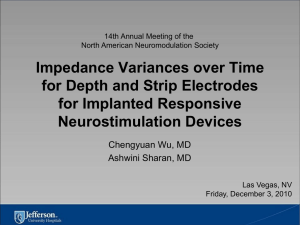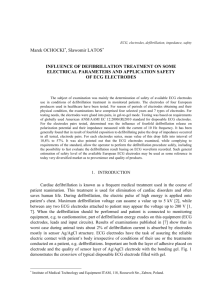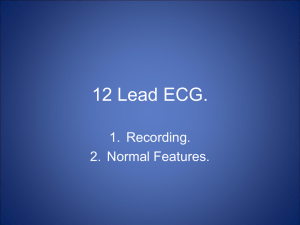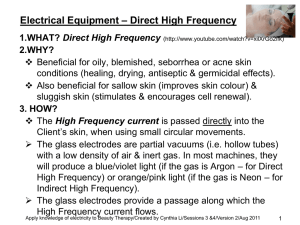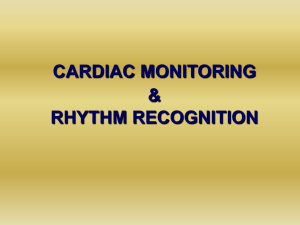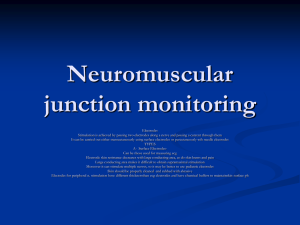Marek OCHOCKI, Slawomir LATOS Institute of Medical
advertisement
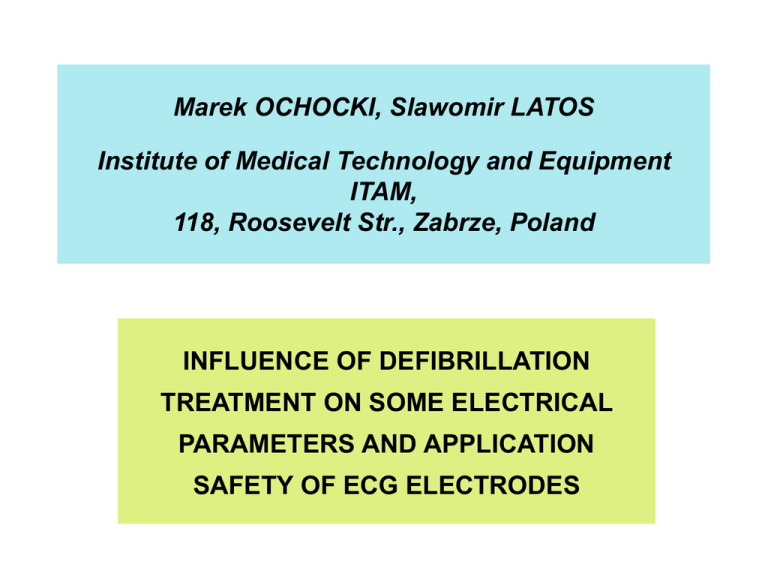
Marek OCHOCKI, Slawomir LATOS Institute of Medical Technology and Equipment ITAM, 118, Roosevelt Str., Zabrze, Poland INFLUENCE OF DEFIBRILLATION TREATMENT ON SOME ELECTRICAL PARAMETERS AND APPLICATION SAFETY OF ECG ELECTRODES Presentation scheme • • • • • • The subject of presentation Introduction Examination procedure Examination results Conclusions Wider context The subject of presentation • A contribution to determination of safety of disposable ECG electrodes use in conditions of defibrillation treatment in monitored patients for risk stratification and referential purposes ECG electrodes available on the Polish market 4 European manufacturers including Polish one • Illustration of relations between patient’s safety, standards, market considerations, compliance to standards and regulations as well as research activity Introduction Fig. 1 ECG electrode filled with gel Introduction Fig. 2 Schematic representation of electrodegel-patient’s skin structure and its equivalent circuit model according to [3] Introduction • ECG recording or monitoring • The use of cardiac defibrillation treatment – Defibrillation voltages transposed up to 200 V between ECG electrodes on patient’s body • Hazards to ECG electrodes and patients – Up to 2% of defibrillation current absorbed by electrodes, mostly in sensor Ag/AgCl structure – Degradation of sensor layer - impairment of electrode characteristics [3] – Electrodes polarization (publication [6]) – Rise of electrodes impedance – next slide: Increase of ECG electrodes impedance may cause: • unwanted decrease of common mode rejection ratio (CMRR) of ECG amplifier channel. • raise of disturbing interference of alternative current on ECG waveform [5]. • augmentation of exuded energy during defibrillation or even electrosurgical operation involving possible heating up of electrodes and the patient's burns [3]. Procedure of ECG electrodes examination • Selection of electrodes • Tests distribution in years • Gluing electrodes in gel-to-gel mode into pairs – correspondence to impedance measurement on abraded patient’s skin [4] • Measurement of polarization potential of electrodes 60÷90 s after gluing • Measurement of impedance with the 10 Hz current • Fourfold defibrillation recovery test − according to schematic diagram in Fig. 4 • Measurement impedance with the 10 Hz current after defibrillation Testing according to globally recognized standard: American National Standard ANSI/AAMI EC12:2000/(R)2010 Disposable ECG electrodes AAMI Association for the Advancement of Medical Instrumentation The photo of measuring equipment set for ECG electrodes testing tested electrode pair measuring amplifier oscilloscope sinusoidal current source of efficiency 80µA/10Hz Ka=12,5V/V Fig. 3 Measurement circuit for testing the electrodes impedance with 10 Hz current Fig. 4 Instrumentation system for defibrillation recovery testing of ECG electrodes according to standard [1] Fig. 5 Electric scheme for defibrillation recovery testing of ECG electrodes according to [1] Results • Initial self-polarization potential („DC offset voltage”), measured in simple circuit after 60÷90 s stabilization period of glued electrode pairs did not exceed 6 mV in all the measurements of 2012 year. • In previous years indicated, these voltages were also far below 100 mV upper allowable limit according to [1] Polarization recovery from defibrillation induced overload in 2012 tests • Measurements 5 secs after each of four discharges of 200 V did not exceed 21 mV in all tests of 2012 year. The upper permissible limit being 100 mV [1] • Rate of decrease of induced polarization potential during 30 secs following each ‘5 secs’ measurement did not exceed 0,5 mV/s (permissible maximum 1 mV/s [1]) Polarization potential [mV] 30 25 20 15 10 5 0 00:00 00:15 00:30 00:45 01:00 01:15 01:30 01:45 02:00 02:15 02:30 02:45 03:00 03:15 03:30 Time [min:s] Fig. 6 Example of recovery polarization potential in time after a series of four defibrillation-like expositions impacting the electrode pair chosen Table 1. Results of impedance measurements for electrode pairs examined, in four selected years Years of examinations conducted Measured Impedance Parameters Impedance interval before defibrilla -tion k 2006 2007 2011 Each year one electrode type from one producer, and quantity of 12 electrode pairs tested 0,29÷ 0,38 0,41÷ 0,48 0,04÷ 0,06 2012 Electrode types of one producer and quantity of electrode pairs tested A 7 pairs 0,21÷ 0,41 B C D 12 pairs 12 pairs 12 pairs 0,23÷ 0,46 0,18÷ 0,29 0,16÷ 0,34 Mean impedan ce value before defibrillation k 0,34 0,44 0,05 0,27 0,34 0,22 0,22 Impedance interval after defibrilla -tion k 0,28÷ 0,32 0,30÷ 0,37 0,03÷ 0,04 0,17÷ 0,37 0,08÷ 0,22 0,07÷ 0,13 0,12÷ 0,16 Mean Impedan -ce value after defibrillation k 0,30 0,34 0,04 0,23 0,15 0,10 0,15 Interval of impedance drop % 0,0÷ 23,7 9,9÷ 31,4 17,2÷ 29,5 2,2÷ 21,9 46,9÷ 71,7 51,1÷ 69,6 12,1÷ 55,4 Mean value of impedance drop % 10,8 21,8 22,3 13,8 56,3 57,0 31,2 End of Table 1. Changes of electrode impedance In result of fourfold defibrillatory exposition the impedance drop in all examined electrode pairs has occurred. Mean value of this drop for each electrode lot falls into 10,8% do 57% interval. Checked ECG electrodes comply with the American standard [1], to not exceed 2 kΩ by the mean impedance value for each production lot of 12 electrode pairs, and individually be below 3 kΩ. Conclusions • All tests have been complied to globally recognized American standard [1] with considerable safety margin. • The results of conducted examinations generally have put in a good light the quality of tested ECG electrodes of four selected European manufacturers, including Polish one, • This made possible safe use of these electrodes on patients undergone the serious treatment as cardiac defibrillation. • In that important was (or is) to allow the physician obtaining quickly information for assessment of effectiveness of this defibrillation procedure. Conclusions • Referential meaning of these examinations - wider analyses, risk stratifications… • On today market more and more medical devices appears from outside Europe. their quality is not stable. • Periodic checking of accessible sample lots of such products - advisable • Special care for long-term and little controlled transport and storage periods as well as rough conditions • Particular care for semi-liquid materials like the gels. • Essential performance – new kind of safety in standards for electromedical equipment – here represented For further analysis two other low intensity parameters also positively tested meaningful phenomena, required by the American standard [1] : 1. Combined offset instability and internal noise After a 1-min stabilization period, a pair of electrodes connected gel-to-gel shall not generate a voltage greater than 150 microvolts (μV) p-p in the passband of 0.15 to 100 Hz, for a period of 5 min following the stabilization period. Fig. 7 Test circuit for offset instability and internal noise measurement [1] 2. Bias current tolerance: Observed DC voltage offset change across a glued pair of electrodes required to not exceed 100 mV when the pair is subjec-ted to a continuous 200 nano-ampere DC current during at least 8 hours. BIBLIOGRAPHY [1] ANSI/AAMI EC 12:2000/(R)2010 Disposable ECG electrodes. [2] EN 60601-1:2006 Medical electrical equipment. Part 1: General requirements for basic safety and essential performance. [3] HOI-JUN YOO, VAN HOOF CH. Bio-Medical CMOS ICs (Integrated Circuits and Systems) 2011, pp 31-124, Springer, New York [4] KLINGLER DR, SCHOENBERG AA, WORTH NP, EGLESTON CF, BURKART JA. A comparison of gel-to-gel and skin measurements of electrode impedance. Med. Instrum. 1979 Sep-Oct;13(5):266-8. [5] OLSON WH, SCHMINCKE DR, HENLEY BL. Time and frequency dependence of disposable ECG electrode-skin impedance. Med. Instrum. 1979 Sep-Oct;13(5):269-72. [6] PATTERSON RP. The electrical characteristics of some commercial ECG electrodes. J Electrocardiol. 1978 Jan;11(1):236 [7] SCHOENBERG AA, BOOTH HE, LYON PC. Development of standard test methods for evaluating defibrillation recovery characteristics of disposable ECG electrodes. Med. Instrum. 1979 Sep-Oct;13(5):259-65

